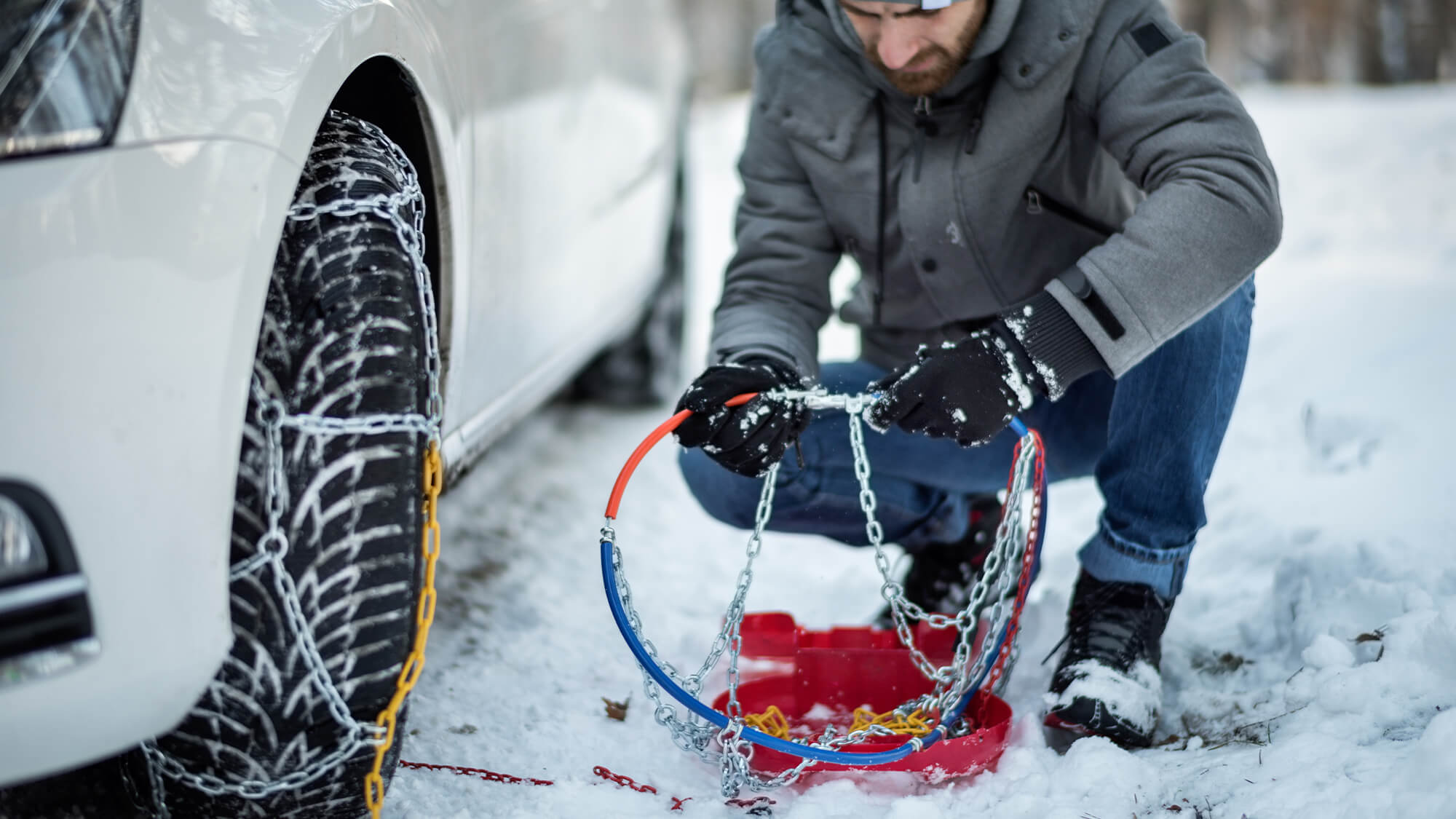Mit dem Auto in den Skiurlaub zu fahren, ist zweifelsohne eine Reise der besonderen Art. Sie reisen mit viel Gepäck, auf glatten und verstopften Straßen. Damit diese Reise vollkommen sicher abläuft, finden Sie im Folgenden einige Tipps zur Vorbereitung und zum Fahrverhalten.

Winterreifen
Bei Schnee, Regen oder trockenem Wetter verbessern Winterreifen Ihre Bodenhaftung, sobald es kalt ist (weniger als 7 °C).
In Luxemburg ist die Nutzung von Reifen mit der Kennzeichnung „M+S“ bei winterlichen Straßenverhältnissen (Schnee, Glatteis, Frost) selbst außerhalb der Wintermonate vorgeschrieben. Dies ist jedoch nicht überall der Fall.
Wo sind Winterreifen Pflicht?
- Frankreich: In bestimmten Departements der Alpen, Pyrenäen, des Zentralmassivs, im Jura, den Vogesen und auf Korsika muss Ihr Fahrzeug „M+S“-Reifen, Schneeketten oder Schneesocken haben.
- Schweiz: Winterreifen werden dringend empfohlen. Im Falle eines Unfalls oder Verkehrsstillstands riskieren Sie ein Bußgeld für das Fehlen geeigneter Reifen.
- Italien: Die Region Aostatal schreibt Winterreifen vor, bzw. das Mitführen von Schneeketten an Bord des Fahrzeugs.
- Deutschland: Genau wie in Luxemburg verlangen winterliche Straßenverhältnisse die Nutzung von Winterreifen. Die „M+S“-Kennzeichnung hingegen reicht nicht aus. Der Reifen muss auch das Schneeflockensymbol tragen, das die „alpin“-Zertifizierung darstellt.
- Österreich: Bei winterlichen Straßenverhältnissen ist die Nutzung von „M+S“-Reifen Pflicht. In bestimmten Gebieten können auch Schneeketten vorgeschrieben sein.
Sind M+S-Reifen Winterreifen?
Das Symbol M+S ist eine Kennzeichnung des Herstellers, die bedeutet, dass die Reifen für das Fahren bei Schnee und Matsch (Mud and Snow) geeignet sind.
Sie bestehen aus weicherem Gummi und haben tiefere Profile, dennoch bieten sie keine echte Leistungsgarantie bei winterlichen Straßenverhältnissen. Kein standardisierter Test bestätigt offiziell ihr Verhalten auf glatten Straßen.
Aus diesem Grund verlangen viele europäische Länder zunehmend die Nutzung von Reifen mit der „alpin“-Zertifizierung, die durch das 3PMS-Logo (Three Peak Mountain Snow Flake) ausgewiesen wird. Dieses Logo stellt eine Schneeflocke in der Mitte eines Gebirges mit drei Gipfeln dar. Das ist die einzige legale und offizielle Garantie für eine bessere Fahrleistung auf verschneiten Straßen.
Wenn Sie mehr über Winterreifen und die verschiedenen Kennzeichnungen an den Reifenflanken erfahren möchten, lesen Sie unseren Artikel speziell über Winterreifen.
Wann sind Schneeketten anzulegen?
Sobald Sie in die Berge kommen und sicher sind, auf wirklich winterliche Verhältnisse zu treffen, ist es ratsam (und manchmal sogar vorgeschrieben), Schneeketten an Bord des Fahrzeugs mitzuführen.
Schneeketten erlauben optimalen Grip selbst auf einer hohen Schneeschicht.
Sie müssen auf die Antriebsräder Ihres Fahrzeugs montiert werden und bei einem Allradantrieb idealerweise auf alle vier Räder.
Um nicht völlig überrumpelt zu werden und die Nutzung unter schwierigsten Bedingungen herauszufinden, empfehlen wir Ihnen, sich vor der Abreise in aller Ruhe mit der Nutzung der Schneeketten vertraut zu machen.
Achten Sie darauf, mit den Schneeketten nur auf Schnee zu fahren. Sie sind nicht für andere Oberflächen ausgelegt und erlauben das Fahren nur bis zu einer Geschwindigkeit von 30 km/h.
Die Alternative der Schneesocken
Für denselben Preis, aber etwas einfacher zu montieren, können Sie die Schneeketten durch Schneesocken ersetzen. Der Gewinn an Bodenhaftung ist ähnlich und Sie können mit einer Geschwindigkeit von bis zu 50 km/h fahren.
Vergessen Sie nicht, dass Sie mit Schneeketten und Schneesocken nur auf Schnee fahren können.
Überprüfen Sie die Flüssigkeitsstände
Vor jeder größeren Fahrt wird empfohlen, die verschiedenen Flüssigkeitsstände Ihres Fahrzeugs zu überprüfen. Dies ist umso wichtiger im Winter, wo Sie bei starker Kälte keine Panne haben möchten.
Überprüfen Sie daher den Stand von Motorenöl, Bremsflüssigkeit, Servoöl, Kühlflüssigkeit und Scheibenreiniger.
Spezialflüssigkeiten für extreme Kälte?
Achten Sie auch darauf, dass all diese Flüssigkeiten für Minustemperaturen geeignet sind.
Die meisten Motorenöle sind bis zu -25 °C wirkungsvoll, doch gibt es auch Öle mit einem Index „0“, die auch extremen Temperaturen (-30 °C und -40 °C) und dem Hochgebirge standhalten.
Kühlflüssigkeiten sind in der Regel für die meisten winterlichen Verhältnisse geeignet. Die günstigsten Produkte können bis zu -20 °C und die besten bis zu -35 °C standhalten.
Der Scheibenreiniger schließlich muss auf jeden Fall ein Winterprodukt sein, andernfalls besteht die Gefahr des Gefrierens. Die besten Produkte können Temperaturen von bis zu ‑30 °C aushalten.
Reflexe und Vorsicht
Muss man im Winter sein Fahrverhalten in den Bergen anpassen? Die Zufahrtsstraßen zu Skigebieten sind oft geräumt und befahrbar, aber Achtung vor unvorhergesehenen Ereignissen. Bei Schnee auf der Straße gilt höchste Vorsicht und es muss mit Situationen mit wenig Bodenhaftung wie Feuchtigkeit oder Glatteis gerechnet werden.
Fahren Sie vorausschauend, behalten Sie die Kontrolle, halten Sie Sicherheitsabstände ein, vermeiden Sie plötzliches Abbremsen und beschleunigen Sie bedächtig. Nehmen Sie insgesamt ein sanftes Fahrverhalten an.
Noch ein paar zusätzliche Tipps
- Fahren Sie mit einem vollen Tank: Wenn Sie aufgrund einer unbefahrbaren Straße, einer Panne oder eines Unfalls stillstehen müssen, können Sie bis zum Eintreffen des Rettungsdienstes Ihre Heizung nutzen.
- Reisebusse nutzen in Haarnadelkurven beide Seiten der Fahrbahn. Lassen Sie ihnen die Zeit zum Manövrieren und schauen Sie stets weit voraus.
- Vergewissern Sie sich, dass Ihre Scheibenwischer nicht eingefroren sind und den Schnee auf Ihrer Windschutzscheibe entfernen können.
- Führen Sie in Ihrem Fahrzeug eine volle Flasche Winterscheibenreiniger mit.
- Nutzen Sie beim bergab Fahren eher die Motorbremse als das Bremspedal. Aktivieren Sie bei einem Automatikfahrzeug den sequenziellen Modus.
- Wenn die Fahrbahn nicht breit genug für zwei sich entgegenkommende Fahrzeuge ist, hat das hochfahrende Fahrzeug Vorrang.
Bereiten Sie sich optimal auf Ihren Urlaub vor und entdecken Sie die anderen Artikel in unserer Rubrik „Ruhiger Wintersport“ : Bergrettung, Wie man Verletzungen vermeidet und Wintersportversicherungen.



